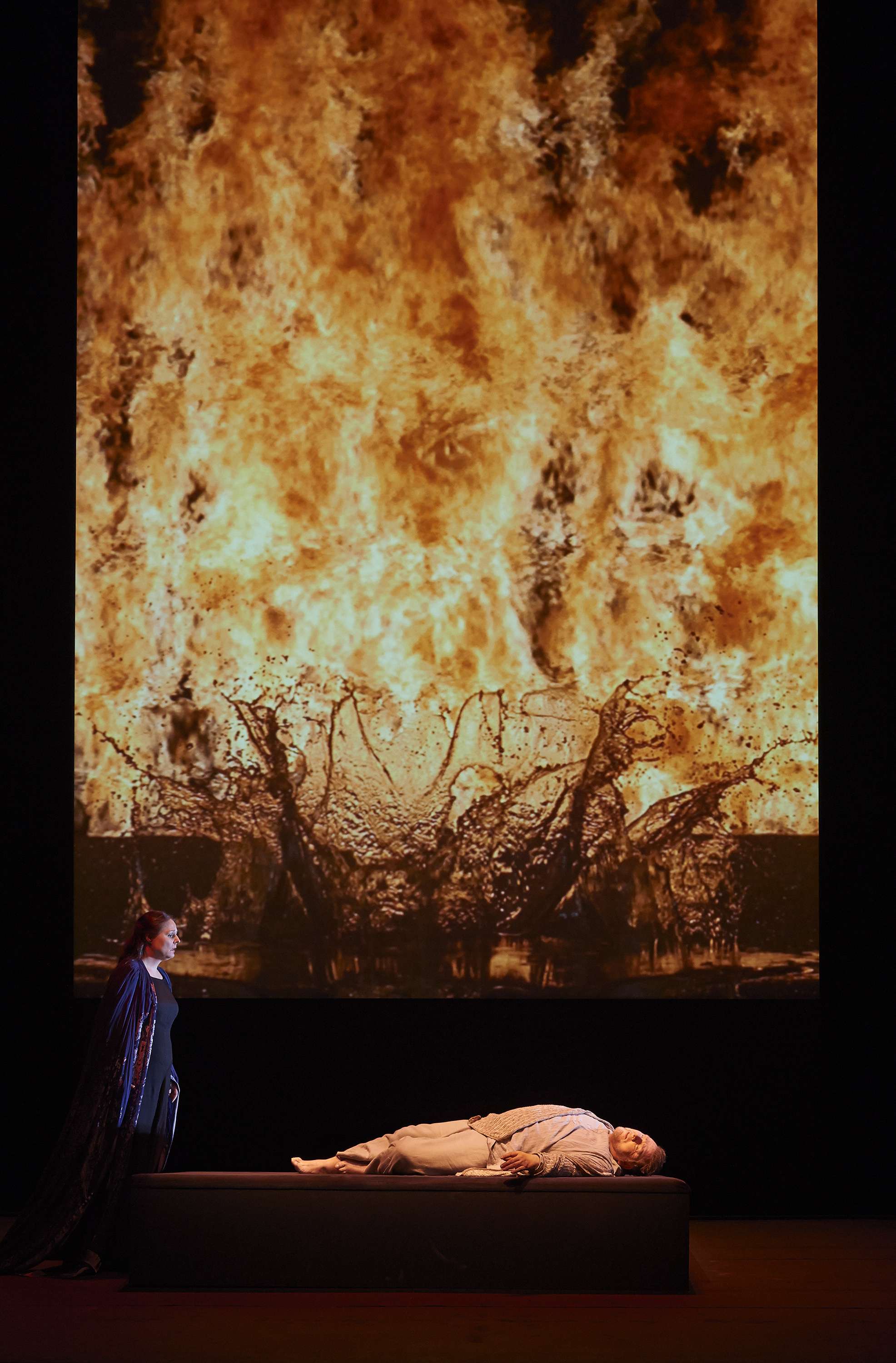|
Back
A special event indeed! Toronto
The Four Seasons Centre for the Performing Arts
01/29/2013 - & February 2, 8, 14, 17, 20, 23, 2013
Richard Wagner: Tristan und Isolde
Ben Heppner*/Michael Baba (Tristan), Melanie Diener*/Margaret Jane Wray (Isolde), Daveda Karanas (Brangäne), Franz-Josef Selig (Marke), Alan Held (Kurwenal), Ryan McKinny (Melot), Owen McCausland (A Young Sailor), Adam Luther (A Shepherd), Robert Gleadow (A Steersman)
The Canadian Opera Company Chorus, Sandra Horst (Chorus Master), The Canadian Opera Company Orchestra, Johannes Debus (Conductor)
Peter Sellars (Director), Bill Viola (Visual Artist), Martin Pakledinaz (Costume Designer), James F. Ingalls (Lighting Designer)

M. Diener & B. Heppner (© Michael Cooper)
The Canadian Opera Company’s production of Tristan und Isolde has attracted a great deal of attention - and ticket sales - for many good reasons.
The big question in everyone’s mind (even people who don’t attend opera) is how is Ben Heppner’s performance. In recent years in Toronto he has come a cropper in recitals (notably in his previous appearance at the Four Seasons Centre in 2010 - reviewed on this website). Judging from the first performance the curse has more or less been lifted. There are a few patchy, brief moments, but basically he gives an all-out performance of a legendarily demanding work that eminently suits his voice. He is especially impressive in the vocal minefield of Act III. Let’s hope he keeps it up. (And this bodes well for his Peter Grimes we are to hear this coming fall.)
Melanie Diener approaches the role of Isolde from a lyrical rather than helden point-of-view. She has a lovely voice with a firm line and presents a finely-shaded performance. It is a pity that a major part of her Act I solo when she expresses the character's anguish is visually overwhelmed by the huge video projections. Director Peter Sellars and visual artist Bill Viola have devised what is by now a famous set of videos featuring two other couples which in the program are called the Earthly Bodies and Heavenly Bodies. For much of Act I the couple prepare themselves for some sort of ritual and this involves in them removing - very, very slowly - all their clothes. It would take a person with a will of iron to focus on the relatively small, black-clad singers during all this.
At the beginning of each act the videos set the stage in a straightforward way - a turbulent sea for Acts I and III, and a forest at sundown for Act II. At other times images of fire and water are prominent; these work wonderfully well at the end of Act III (see photo above). Overall, detached or abstract images enhance the production better than the lengthy parts that focus on the video characters.
The use of projections has been with us for awhile now. I recall a Ring cycle presented at Artpark, New York, over four years (1985-88) under Christopher Keene. Abstract projections by Jerome Sirlin kept the eye engaged without detracting from the stage action.
Bill Viola’s projections were first shown in 2004 during concert performances of the opera by the Los Angeles Philharmonic Orchestra. The production was staged in Paris the following year, but the minimal staging of the performers seems a holdover from the concert performances. There is not much action in the work at the best of times, and in this case the performers are largely confined to small lit squares which they occasionally wander from. They mostly wear mundane black costumes. It is hard at times to tell the two woman apart.
Daveda Karanas (Brangäne) has somewhat of a beat in her voice at first, but then she settles in to giving a performance that fits right in with the overall high standard of the production. Alan Held was Kurwenal in the 2004 concerts and it comes as no surprise that he gives a vivid, committed performance. Mark McKinny makes a good impression in the brief role of Melot.
Franz-Josef Selig is a riveting King Marke. I notice he will be giving a free noon-hour recital (Schubert and Strauss) at the Four Seasons Centre on Feb. 12 - this should be a treat.
The smaller roles are all well handled. The male chorus of 24 is placed in a balcony which makes their somewhat rough-edged approach even more effective. Many off-stage brass players are stationed throughout the higher reaches of the auditorium as well.
The singers are given sensitive yet solid support throughout by the orchestra under Johannes Debus. He was originally supposed to be in the city for the other opera this season, Mozart’s La Clemenza di Tito; however Jiri Belohlávek cancelled his Tristan commitment some weeks ago, so Debus stepped in. The opera-going public in Toronto has a massive collective crush on the unassuming, boyish maestro, and his handling of this will only strengthen the love affair. The orchestra is augmented to 92 players, but even the richest passages have a transparency and glow. An example of the attention paid to detail is the use of a holztrompete - a wooden trumpet - which was made to Wagner’s specifications for this production. This is the instrument that heralds the arrival of Isolde’s ship in Act III and it emits a uniquely strange tone.
For those interested in such figures, Maestro Debus’s timings result in four hours and five minutes of music.
A production of Tristan und Isolde ought to be an extra-special event for an opera company and this one fulfils that requirement superbly.
The performances of Feb 8 and 23 will feature Margaret Jane Wray as Isolde and Michael Baba as Tristan.
Michael Johnson
|